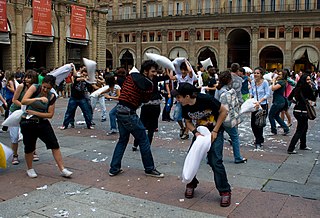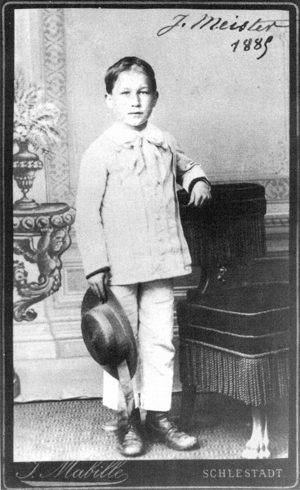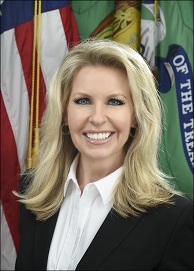
"Flash Crowd" is a 1973 English-language novella by science fiction author Larry Niven, one of a series about the social consequence of inventing an instant, practically free displacement booth.

Emily Elizabeth Dickinson was an American poet. Little-known during her life, she has since been regarded as one of the most important figures in American poetry. Dickinson was born in Amherst, Massachusetts, into a prominent family with strong ties to its community. After studying at the Amherst Academy for seven years in her youth, she briefly attended the Mount Holyoke Female Seminary before returning to her family's home in Amherst. Evidence suggests that Dickinson lived much of her life in isolation. Considered an eccentric by locals, she developed a penchant for white clothing and was known for her reluctance to greet guests or, later in life, even to leave her bedroom. Dickinson never married, and most of her friendships were based entirely upon correspondence.
Stephen Randall Glass is an American former journalist. He worked for The New Republic from 1995 to 1998 until it was revealed many of his published articles were fabrications. An internal investigation by The New Republic determined the majority of stories he wrote either contained false information or were fictitious.

A flash mob is a group of people that assembles suddenly in a public place, performs for a brief time, then quickly disperses, often for the purposes of entertainment, satire, and/or artistic expression. Flash mobs may be organized via telecommunications, social media, or viral emails.

Kurt Andersen is an American writer, the author of novels and nonfiction as well as a writer for television and the theater.

Town & Country, formerly the Home Journal and The National Press, is a monthly American lifestyle magazine. It is the oldest continually published general interest magazine in the United States.

Joseph Meister was the first person to be inoculated against rabies by Louis Pasteur, and likely the first person to be successfully treated for the infection, which has a >99% fatality rate once symptoms set in.

Benjamin Alvord was an American soldier, mathematician, and botanist.

Monica Elizabeth Crowley is the former Assistant Secretary for Public Affairs for the U.S. Department of the Treasury. She has been a political commentator and lobbyist. She was a Fox News contributor, where she worked from 1996 to 2017. She is a former online opinion editor for The Washington Times and a member of the Council on Foreign Relations.

Valerie Martin is an American novelist and short story writer.

Amy Hempel is an American short story writer and journalist. She teaches creative writing at the Michener Center for Writers.
Ecco is a New York–based publishing imprint of HarperCollins. It was founded in 1971 by Daniel Halpern as an independent publishing company; Publishers Weekly described it as "one of America's best-known literary houses." In 1999 Ecco was acquired by HarperCollins, with Halpern remaining at the head. Since 2000, Ecco has published the yearly anthology The Best American Science Writing, edited by Jesse Cohen. In 2011, Ecco created two separate publishing lines, one "curated" by chef-author Anthony Bourdain and the other by novelist Dennis Lehane.

Jerome Charyn is an American writer. With nearly 50 published works over a 50-year span, Charyn has a long-standing reputation as an inventive and prolific chronicler of real and imagined American life, writing in multiple genres.

jubilat is a widely distributed, highly acclaimed American poetry and prose journal headquartered at the University of Massachusetts Amherst. First published in 2000, it was founded by Rob Casper, Christian Hawkey, Michael Teig and Kelly LeFave. From its first issue onward, jubilat has aimed to publish what's most alive in contemporary American poetry, and to place it alongside selections of reprints, found pieces, prose of various kinds, art, and interviews with poets and other artists.

John Cullen Murphy, Jr. is an American writer, journalist and editor who was managing editor of The Atlantic magazine from 1985 to 2006.

Robert F. Marx was an American pioneer in scuba diving, a prolific author, and was best known for his work as an avocational marine archaeologist. Over his career, he discovered over 5000 shipwrecks in over 60 countries. Although some accused him of treasure hunting, fellow avocational archeologist E. Lee Spence described Marx as the "true father of underwater archaeology". Marx also helped write UNESCO legislation regarding shipwrecks.

Mabel Loomis Todd or Mabel Loomis was an American editor and writer. She is remembered as the editor of posthumously published editions of Emily Dickinson's poetry and letters and also wrote several novels and books about her travels with her husband, astronomer David Peck Todd, as well as co-authoring a textbook on astronomy.

The New Hampshire Union Leader is a daily newspaper from Manchester, the largest city in the U.S. state of New Hampshire. On Saturdays, it publishes as the New Hampshire Sunday News.

Howard Bloom is an American author. He was a music publicist in the 1970s and 1980s for singers and bands such as Prince, Billy Joel, and Styx. He has published a book on Islam, The Muhammad Code, an autobiography, How I Accidentally Started The Sixties, and three books on human evolution and group behavior: The Genius of the Beast, Global Brain, and The Lucifer Principle.

Art Cluster, in global contemporary art scene, refers a group of artists that work through Internet to promote the free culture and many artistic values. The emerging telecommunications have developed a new form of communication, much faster and more direct. This allows people to work from anywhere in the world. People can easily group or perform any type of organization. Art Cluster also refers artistic production of collective intelligence. The integration of social movement in the cyberspace is one of the potential strategies of this social movement.

















